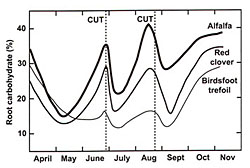Competency Area 2: Crop Staging, Growth and Development
PO 10. Recognize the relationship between the growth and development of major Northeast crops and management factors.
Relationship between Growth and Development and Management – Forages:
Alfalfa.
Initial growth in the spring relies on nonstructural carbohydrates in the alfalfa taproot, until the plant is 6-8 inches tall. Then carbohydrates are accumulated in the roots until either full bloom or harvest. Root carbohydrates are then used again to initiate regrowth from crown buds. Cyclic accumulation and depletion of root reserves occurs throughout the harvest season, with a similar pattern in most clovers.
Birdsfoot Trefoil (BFT).
Carbohydrate reserves in BFT follow a cyclic pattern of utilization and storage similar to alfalfa, but less pronounced. Carbohydrate reserves are at a relatively low level during most of the growing season for BFT. The low accumulation of carbohydrate reserves maintained by BFT explains why it is best to leave some photosynthetic area on the plants when grazed. BFT can persist under frequent, but not close, grazing better than alfalfa or red clover, even though it has a low level of carbohydrate reserves. BFT does not perform well under high temperature conditions.
Red Clover.
Red clover is a relatively short-lived perennial which usually behaves as a biennial in the northern USA. Red clover is one of the most rapid growing and competitive perennial forage crops, which can succeed with frost seeding. Seasonal fluctuations of available carbohydrate reserves are similar to that of alfalfa. Flowering is influenced by the length of the light period, it is possible to reseed red clover in a stand by allowing the crop to go to seed. Red clover does perform well under high temperatures or low soil moisture, and has a number of diseases that cause economic damage.
Quick Links
- Competency Area 1: Crop Adaptation
- Competency Area 2: Crop Staging, Growth, and Development
- Competency Area 3: Tillage Systems
- Competency Area 4: Seeding Factors
- Competency Area 5: Seeding Rates and Row Spacing
- Competency Area 6: Considerations in Replanting Decisions
- Competency Area 7: Forage Harvesting Factors
- Competency Area 8: Cropping Systems

